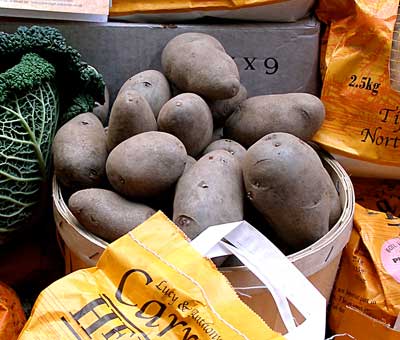
Shetland Black is a mealy-textured, nut-flavoured turn of the century potato with an inky black covering which hides mauve-streaked flesh. This forms an exotic violet edge next to the skin when it is baked. This variety is also good as an interesting option for boiling and baking.
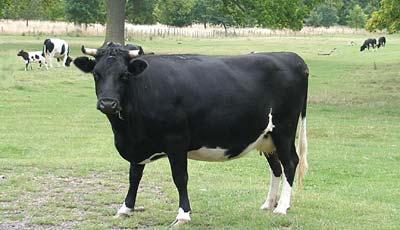
A rare breed of cattle with a truly distinctive flavour. Shetland cattle closely resemble the Jersey, Canadian and Breton breed in conformation but Shetlands are Scandinavian in origin. They remained pure until the mid-1800s when small numbers of Shorthorn, Angus and Highland cattle were introduced to the Shetland Islands. In the 1920s, Friesian cattle were imported which resulted in the existing coloration of the breed of black-and-white while historically dun and red-pied animals predominated. Originally these animals were a small, angular dairy breed with legendary longevity and resistance to diseases. Over time, and with the introduction of other breeds, they have increased in size.
Shetland is a second early Scottish potato. Flesh and skin darken as it matures. Can be boiled or steamed.
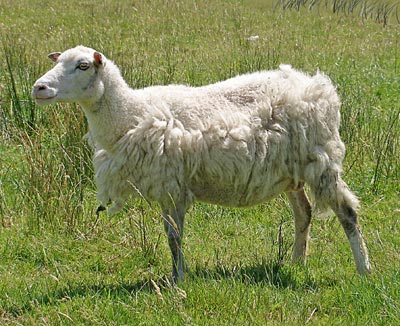
Although Shetland sheep are an ancient breed, possibly even dating back to the Iron Age, they have become rarer in Scotland as Shetlanders abandoned sheep farming for the oil industry in recent times. In 1977 the British Rare Breeds Surivival Trust classified them as endangered. Since then, efforts to rehabilitate them have been successful and they are no longer considered to be endangered. They were exported to Canada first in 1980 and then to the United States in 1986, where there are now estimated to be some 1,000 head. These are small, compact animals which produce good lamb but are not the best for mutton. They come in a variety of colours, expressing the moorit gene for brown colour. They come in a number of shades, from golden brown or, reddish brown through to a dark greyish brown, as well as a bright white or black. Many colors are still identified by their Shetland dialect names - "Emsket" for dusky bluish grey; "Shaela" for dark steely grey resembling black frost; "Mioget" for light golden brown, etc.
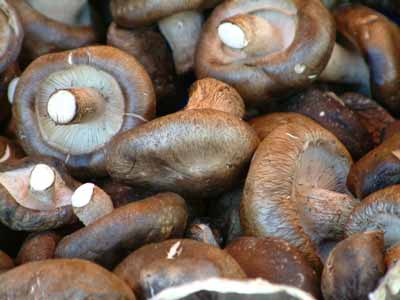
Shiitake mushrooms are indigenous to the forests of China, containing eritadenine which helps to lower blood cholesterol levels. They are found growing on tree trunks in the Far East and have white stems and brown fleshy caps with white ruffled gills. Mushrooms with the edges slightly tucked under, rather than spread flat, are the best ones. Fresh shiitake are grilled and are used in soups and miso, as well as in deep-fried, nabe and custard dishes. Dried shiitake are darker in colour and have an intense, smoky, 'umami' flavour. They are sometimes sold as "winter mushrooms", which are produced in colder conditions and are especially highly regarded. In Russia they are frequently pickled. (If gathering mushrooms you must be absolutely certain what you have before you eat them as many are very poisonous.)
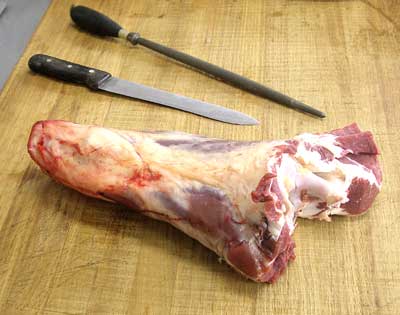
Shins (US: shanks) come from the forelegs or the hindlegs. When cooked, the marbling gives them a characteristically rich, tasty, gelatinous quality. Excellent for stews and casseroles, beef tea and stock.
Atlantic silverside or sandsmelt. A slender, round, oily marine fish which grows up to18 cm (7”). It is long with a translucent green back and silver bands lengthways along the sides and caught in estuaries along the coast of the eastern United States. It is usually deep-fried or grilled. In the United States these are often called whitebait. When tiny they are treated in the same way as whitebait in the UK.
Scaly tooth mushroom or tiled hydnum, an edible fungus with a slightly bitter aftertaste.